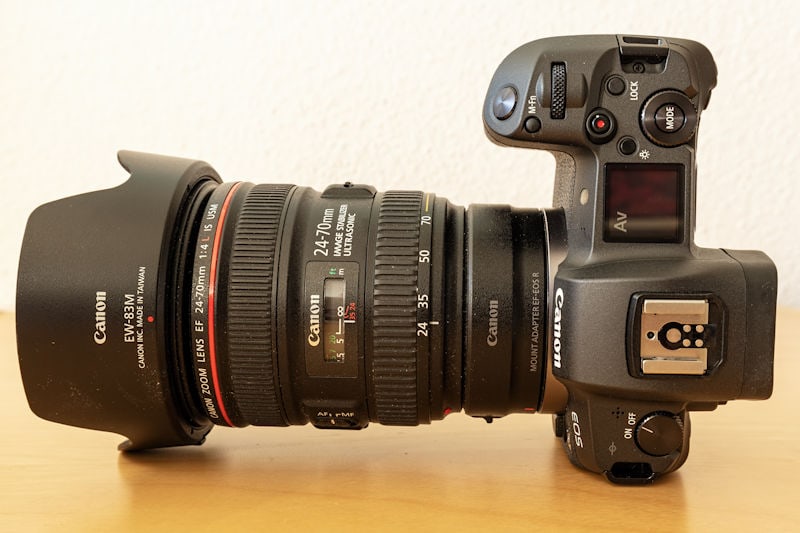I put the new Canon EOS R full-frame mirrorless camera through extensive testing. In this review, you can find out everything there is to know about the camera, whether it really is the next big thing for Canon, and what the strategy behind it is.
I have to admit, it’s been a long time since I’ve been so curious, anxious, and excited about a camera test. The Canon EOS R already had the makings of a game-changer for Canon on paper. Accordingly, I was curious to see how it would feel and whether my theoretical impression would be confirmed in practice.
[amazon box=”B07H484HLT” template=”vertical”]
Items
I have the Canon EOS R in a package with the EF-EOS R lens adapter and the fine RF 24-105mm f/4 L IS USM, which I will highlight in a separate review. In the large box I find the following:
- EOS R body
- RF 24-105mm f/4 L IS USM lens
- Bayonet adapter EF-EOS R
- Battery LP-E6N
- Battery charger LC-E6E
- Camera body cover R-F-5
- Carrying strap ER-EOS R
- Lens hood EW-83N
- Lens bag LP1319
- Lens cap E-77 II
- Lens cap RF
- Camera body cap R-F-3
- 2 x lens back caps RF
- Power cable
- Interface cable IFC-100U (without protection)
- USB cable protection IFC-100U
- Instructions
First impression
Even when unpacking the camera and looking at it carefully for the first time, a few things stand out. The Canon EOS R is more compact than comparable DSLRs and has a completely new operating concept. I discover a touch bar that I had never seen before. Some of the control buttons are arranged much differently. There is no longer a program dial. The on/off switch on the top is designed differently.

The square shoulder display and the button to start recording videos are pleasing – as is the rotatable and foldable touch display, of course. The latter is brilliant and sharp after switching on. Another great feature is that the EOS R also uses LP-E6N batteries. A nice thing for those switching from the 6DMII or 7DMII.

The camera immediately feels good in the hand, even if the operation seems unfamiliar at first. But already the first pictures, in which I play with a few tulips in the kitchen, convince me and immediately awaken in me the desire to go. Unfortunately, the day is dull and dreary, but that doesn’t stop me from doing just that.
I quickly warm up to the new operating concept and immediately start to fall in love with the camera. It is a bit handier than my own cameras, convinces immediately in terms of image quality and I also like the operation more from photo to photo. Only with the touch bar, on which I have put the ISO settings, I do not really warm up yet. But maybe that’s just a matter of habit.

I quickly realize that I absolutely have to test the camera with all my lenses, because – I’m already seriously considering a purchase of this great camera. Accordingly, I take various photographic walks in the following weeks – among others with the 70-300 L IS USM, the 24-70 L IS USM, the standard RF 24-105 L IS USM.
Technical details
| Manufacturer | Canon |
| Model | EOS R |
| Camera type | mirrorless system digital camera (DSLM) |
| Lens bayonet | Canon RF |
| Sensor | CMOS, 36x24mm |
| Maximum image resolution | 6720×4480 pixels |
| Crop factor | 1.0 |
| Megapixels (effective) | 30.3 |
| Image format | JPEG, RAW |
| AF points | Phase comparison autofocus with 5,655 sensors |
| Burst speed | 8 fps with fixed AF 5 fps with servo AF |
| Video resolution | 3,840 x 2,160 pixels (MP4 video: 4K) 1,920 x 1,080 pixels (Full HD) 1,280 x 720 pixels (HD 16:9) |
| Video frequency | 4K: 30 frames per second Full HD: 60 frames per second HD: 120 frames per second |
| Video format | MP4 (codec H.264) |
| Memory card | 1x SD/SDHC/SDXC and UHS-II |
| Battery pack | 1,865 mAh, enough for 370 pictures |
| Interfaces | Flash sync connection, function handle connection, external GPS, SuperSpeed USB 3.1 USB C, WLAN, HDMI mini-plug output (type C, HDMI-CEC compatible), external microphone input / input (mini-jack stereo), headphone connection (mini-jack stereo), E3 -Interface (remote release) |
| Display size | 3.2-inch Clear View LCD II (2,100,000 dots) |
| Monitor Properties | pivotable by 270°, rotatable by 180°, with touchscreen, adjustable brightness, |
| Viewfinder | Video viewfinder (100% frame coverage) with 3,690,000 pixels, 0.76x magnification factor, diopter compensation (-4.0 to 2.0 dpt) |
| ISO sensitivity | 50, 100, 200, 400, 800, 1600, 3200, 6400, 12800, 25600, 51200, 102400 |
| Self-timer | 2 sec, 10 sec |
| Image processor | DIGIC 8 |
| Exposure Compensation | -3.0 to +3.0 EV with increments of 1/3 to 1/2 EV |
| Program modes | Program AE Shutter AE Aperture Manual (Photos and Videos) Bulb 3 Custom Programs Automatic scene recognition: face, eye |
| Dials | Multifunction Touch Bar Speed dial LC display on top of the camera |
| Image processing | Tone priority Automatic exposure optimization (4 settings) Long exposure noise reduction High ISO noise reduction (4 settings) (photos and videos) Lens correction: – Correction of lens vignetting, chromatic aberration correction Distortion correction (during/after photo recording, only for video recording) – Diffraction correction, Digital Lens Optimizer (during/after taking photos) Size adjustment in M, S1, S22 Crop: JPEG recordings can be cropped in-camera (aspect ratio 3:2, 4:3, 16:9 or 1:1) – 45 crop sizes selectable , from 11% to 95% (diagonal) – switch between portrait and landscape cropping – Image alignment – The crop frame can be moved via the touchscreen RAW image processing Multiple exposures HDR |
| Particularities | Sensor cleaning system Touch bar 143 AF areas Three storage locations for picture styles OLED video viewfinder grid can be displayed (3 x 3, 6 x 4, 3 x 3 + diagonal) Video ISO (100-102,400) Exposure correction video (-3 to +3 EV in 1 /3 and 1/2 levels) Dual Pixel RAW support Magnesium alloy and polycarbonate body with fiberglass parts 1 x UHS-II SD memory card slot |
| Size | 139mm x 98mm x 84mm |
| Weight | 651 g (incl. battery) |
Practical test
I tested the new RF lens extensively, among other things, on a trip to the stronghold of Emmendingen. It convinced me immediately – just like the camera itself. Consistently sharp, high-contrast images, a great focal length range for me as a travel blogger and the balanced handling make photography a real pleasure.
On another trip, I especially looked at the easy-to-use adapter in combination with my favorite telephoto, the 70-300 L IS USM. This combination works great as well. I have not been able to find any limitations. So that means, as an EOS R owner, you can continue to use your existing EF lenses without hesitation.

Of course, I also extensively tested my standard Immerdrauf, the EF 24-70 L IS USM, on the Canon EOS R, because before I will own a complete zoo of RF lenses in case of a changeover, I will probably be on the road with adapters and the existing EF lenses for quite some time. But even this combination has completely convinced me.
What does the Canon EOS R offer?
The Canon EOS R is the company’s first full-frame mirrorless camera. After Canon virtually slept through the entire development over the past few years and Sony kept pulling away, this camera was long overdue. It all nicer to see that Canon is finally not just jumping on the bandwagon, but has actually recognized the signs of the times and is making a complete strategy change.
What I personally like – the DSLM is not just a new mirrorless in the old guise or housing of DSLRs, but actually a new development on all fronts. The housing, the operating concept, new lenses, a completely new camera series (the EOS R is only the first in this series) – Canon is currently putting everything on this card with all its might and that’s a good thing.
But let’s take a closer look at the EOS R. The camera offers a whopping 30 megapixels, which puts it more or less on par with the 5D Mark IV. The high-quality workmanship and the robust magnesium alloy housing, which is sealed against dust and splash water, are just as convincing as the electronic viewfinder and the rotating and folding touch display, which is also brilliant. In addition, there is a partly completely new operating concept, which I will go into in more detail in a moment.

The electronic viewfinder
In the past, I had great reservations about an electronic viewfinder compared to optical ones, and so I was also rather skeptical before my first look through the Canon EOS R’s viewfinder. However, as it turns out after just a few seconds, my concerns were unfounded. Quite the opposite – the electronic viewfinder thrilled me from the very first moment. Thanks to 3.69 million subpixels, the image is pin-sharp. Thanks to the 0.76x magnification, the viewfinder image is large and clear. The dioptric correction works great, so I can shoot without glasses without any problems.
In fact, I have to remind myself that I’m looking at a display and not through a lens – that’s how well done the viewfinder is. Its biggest advantage – I see my scene exactly as I will shoot it. WYSIWYG – what you see is what you get. But the viewfinder really comes into its own in poor lighting conditions. Then you can see more with your eye in the viewfinder than in reality. This is fun and ingenious – especially if you like to take pictures at dusk.
Of course, various helpful information can also be conveniently displayed in the viewfinder. By the way, as soon as you look through the viewfinder, the rear touch display is deactivated.
Touch Display
The LCD screen has a resolution of 2.1 million pixels and, as with the 6DMII, can be folded and rotated. The display is bright, sharp, and brilliant and is also used to manually set the autofocus fields. The touch display responds quickly, reliably and can be operated very easily and very accurately. It is also possible to rotate the display forwards.

Shoulder display
The square shoulder display shows the currently selected program mode even when switched off and can of course also be illuminated. The display content can be switched.

The image quality of the EOS Canon EOS R
The image quality of the Canon EOS R is excellent. The colors are convincing, the images are sharp and brilliant – both in JPEG mode and in RAW format. In the JPEGs, I can’t detect any noise up to ISO 800 – excellent. In RAW mode, I feel the images are at least on par with those of the 5D Mark IV. This is not surprising, since the sensor of the EOS R is similar to the sensor of the 5D Mark IV. Supposedly, this has even been developed further. However, I was not able to determine this difference. Compared to the 6D Mark II, the Canon EOS R is ahead in terms of image quality – including dynamic range.
All in all, I am very happy with the image quality. The EOS R does not need to hide behind the 5D Mark IV.
Noise performance of the Canon EOS R
The noise performance immediately surprised me in a very positive way. As already mentioned, noise is almost non-existent up to ISO 800. And I would also use ISO 1,600 and ISO 3,200 without hesitation. Only at ISO 6,400 does the noise start to interfere and increase noticeably. But even in this range, it can easily be removed in post-processing. JPEG images are still of really good quality even at ISO 12,800 or even ISO 25,600, which amazed me quite a bit. The in-camera denoising is really very well done.
But also on the RAW images can be in even with high ISO values still work very well. I’ve had my hands on quite a few Canon cameras – so far I haven’t seen one that has convinced me like this. Normally I travel with Auto-ISO in the range of 100-800, with the 6DMII also up to 1,600. With the Canon EOS R, I would have no qualms about going up to 3,200 or even 6,400 in Auto-ISO.
For me, the Canon EOS R convinces with noise all along the line. Up to ISO 6,400, I find the noise performance to be excellent. And even beyond that, the camera can still produce very appealing images. Great!
Handling of the Canon EOS R
One of Canon’s greatest strengths has always been ergonomics in my eyes. So I was all the more surprised that Canon dares to break new ground with the EOS R. I was skeptical at first, but the handling quickly convinced me. The most obvious changes are the missing program dial. In its place is an easy-to-use on/off switch. Instead of a slide switch, this is now represented by a wheel.
Despite the change in size, the body of the EOS R is very comfortable to hold. The grip is perfectly formed. The shoulder display is smaller than on the 6DMII, making room for the new program mode button, which consists of a wheel that can be moved from the back and a button inside that can be pressed from above, and allowing a slightly different arrangement of the other, smaller buttons. The mode dial further forward. and the M-Fn button has remained the same.
On the back, there are significantly fewer buttons than before. The complete operation is now mainly based on the touch display. Accordingly, there is no AF joystick, which I actually like very much. Instead, a touch bar has been added, but I am not convinced of its purpose. It activates too easily without a lock, and it takes too long with a 2-second lock to access the functions stored there. As innovative as the bar maybe, I feel that this space could have been better used. In any case, I didn’t really warm up to this bar even after several photographic walks.
By the way, the internal menu of the camera is as clear as usual and basically has the familiar menus and overviews as in other Canon cameras. So there is little new here, and that’s a good thing.
My conclusion on the new operating concept: it is cleaner, tidier and well thought out. I quickly got used to the new button arrangement and the operating concept and find it extremely successful.
Autofocus of the Canon EOS R
The autofocus is one of the highlights of this camera. A whopping 5,655 autofocus points ensure unerring and swift focusing – even in low-light conditions. Here, the EOS R is clearly superior to the DSLMs and also plays in front in comparison to Sony.
The EOS R features the already known Dual Pixel CMOS AF. New, however, is the autofocus with eye priority, which is especially helpful for portrait shots. The continuous autofocus with subject tracking works well, especially in the telephoto range.
I tested the autofocus while photographing a parade and moving targets – namely the animals in the Mundenhof – and have no criticism. Focusing by automatic and also tracking in video mode work perfectly. I am thrilled!

Strengths of the Canon EOS R short & compact
- Very good ergonomics, great new operating concept.
- High-quality metal housing and protection against dust and splash water.
- Excellent fast and accurate autofocus.
- Brilliant, sharp electronic viewfinder.
- LP-E6N batteries (as used by the 6DMII or 7DMII) can be used.
- New RF lens generation is very sharp and has a lot of potential.
- EF and EF-S lenses can still be used via adapters.
- Sharp and brilliant, rotating and folding touch display.
- Shortest exposure time of 1/8,000 second.
- Autofocus works down to -6 EV.
Weaknesses of the Canon EOS R short & compact
- Moving subjects can only be tracked with a frame rate of five photos per second (without auto AF 8).
- Video mode: strong cropfactor and limitation to 4K recordings.
- No second memory card slot.
- High but reasonable price.
- New swipe bar is not yet polished, no joystick.
- Only around 370 shots per battery possible.
- No in-camera image stabilizer.
- No integrated flash.
Comparison EOS R and 5D Mark IV
The comparison between the Canon EOS 5D Mark IV and the new EOS R turns out to be exciting. There are aspects where one camera is ahead and those that speak for the other. Overall, both cameras are close to each other. However, the RF system and the fact that mirrorless cameras are now also the future for Canon speak for the Canon EOS R as the camera of choice.
| megapixels | ||
| image processor | ||
| lens mount | ||
| number of focus points | ||
| Weight | ||
| shutter life | ||
| resolution | ||
| viewfinder | ||
| screen | ||
| AF coverage | ||
| EV correction | ||
| memory slots | ||
| battery capacity |
Alternatives to the Canon EOS R
Of course, Sony and Nikon also have similarly equipped full-frame mirrorless cameras on offer. Nikon has the Z6, Sony has the A7 III. All three cost just over 2,000 euros. All three have advantages and disadvantages in individual aspects. Purely in terms of the camera, Sony still has a slight lead. In terms of the overall system, I see Canon ahead with the RF lenses in the future. Ultimately, the decision for one of the cameras is a system decision and a question of personal taste. You won’t make a mistake with any of the three cameras.
Who is the Canon EOS R suitable for?
Due to the price, the new EOS R is mainly suitable for photographers with higher demands and professionals. For hobby photographers, the prices of the camera and the corresponding lenses are quite ambitious. I would recommend the EOS R especially to those who are still using the APS-C format and are thinking about going full-frame. From my point of view, you can’t go wrong with the EOS R.
Useful accessories for the Canon EOS R
The EOS R has a solid set of accessories. The most effective way to get started is probably via the KIT combination with the associated simplest of the 3 RF adapters. In addition, a manual for the new camera belongs in the shopping basket and of course, the usual utensils such as memory cards (more MP means larger images and thus more storage space required), carrying case, tripod, and cleaning utensils.
Conclusion
It’s been a long time since I’ve been as excited by a camera test as I was by this one. I started to fall in love with the camera during my first photo walk. It’s handier than my DSLRs, without seeming any less ergonomic. I also like the new operating concept extremely well. I got used to the new handling very quickly.
I had a lot of fun taking pictures with the EOS R. And if I hadn’t just bought the 6DMII about 2 years ago, I’d go for it immediately.
But what excites me most about the EOS R is that Canon isn’t just throwing a new camera into the race, but a completely new, well-thought-out system. There will be different expansion stages of the camera and the new RF lens system already looks very promising. The first 4 RF lenses are convincing all along the line. The announcement of more lenses coming out quickly and soon, at least 7-9 lenses also sounds promising.
From my point of view, the EOS R could become a real game-changer for Canon. For me, it is the clear future, to which I will also switch sooner or later with certainty, as soon as a new camera purchase is pending. Accordingly, I won’t be buying any more EF lenses from now on. Instead, the money will go into the piggy bank so that I can buy one or the other very tempting-looking RF lens when I make the switch.
[amazon box=”B07H484HLT” template=”horizontal”]
Read more: Nikon Z9 Review






